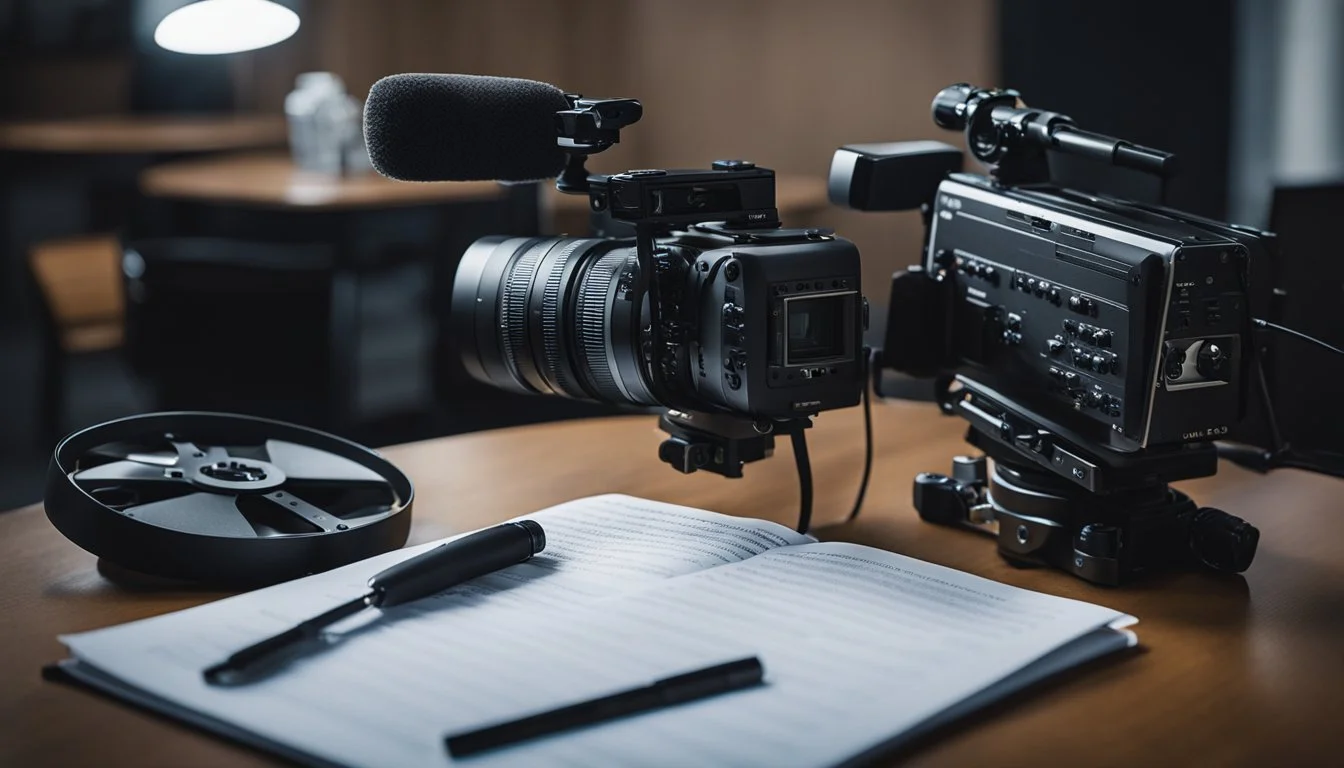13 Expert Tips for Casting the Perfect Actors
A Director's Guide
Casting the right actors for a film can make the difference between a compelling, engaging story and a lackluster performance that fails to resonate with audiences. The process of selecting the perfect cast involves understanding the characters deeply, recognizing the unique qualities each actor brings to the table, and ensuring they can deliver a convincing and cohesive performance.
Casting is an essential component of any film and will take place during the pre-production process. Ensuring the right actors are chosen not only brings characters to life but also enhances the overall production quality, providing a solid foundation for a successful film.
1) Assess Acting Skills
Evaluating acting skills is a critical part of the casting process. Focus on each actor's ability to embody characters that match your film's tone and style. This can be observed effectively through prepared monologues or scene readings.
Pay attention to their emotional range and how convincingly they can deliver a performance. Assess their use of body language and facial expressions, as these are key indicators of their acting prowess.
Consider actors' comfort with improvisation as well. Sometimes, the ability to think and react spontaneously can add depth to a scene and enhance its authenticity.
It's also crucial to see how well they take direction during auditions. This demonstrates their flexibility and willingness to collaborate, which can significantly influence the overall dynamic on set.
2) Evaluate Versatility
Versatility is key when casting actors. Filmmakers should seek out individuals who can adapt to a range of emotions and scenarios. This ability ensures that the actor can handle unexpected script changes or directional shifts.
During auditions, directors should present actors with a variety of scenes. This could include both intense dramatic moments and lighter, more comedic parts. Watching how well actors transition between these scenes reveals their flexibility.
It's also helpful to observe actors in different roles from their past work. Reviewing their previous performances can provide insight into their range. Look for patterns in their acting and assess whether they can convincingly play diverse characters.
Self-tapes and live auditions are both useful in this evaluation process. A self-tape allows the actor to showcase their skills in a controlled environment, while a live audition can display their ability to perform under pressure.
Lastly, discussing the character's journey and development with the actor can be beneficial. This dialogue helps assess if they understand and can embody the character's growth throughout the film. Versatile actors contribute significantly to creating dynamic and engaging characters.
3) Consider Chemistry
Chemistry between actors is critical for believability. Even the best actors can struggle if they lack compatibility with their scene partners. Directors should look beyond individual talent and observe how actors interact with others.
Screen tests can help assess this. Short scenes performed together can illuminate the natural flow and connection between actors. Audiences can sense genuine chemistry, enhancing their engagement with the story.
Watch for non-verbal communication. Subtle gestures, eye contact, and body language can reveal a lot. Actors who respond authentically to each other bring a dynamic energy that scripted dialogue alone cannot achieve.
Consider previous work. Actors who have successfully worked together before may recreate that same magic on your set. Reviewing similar roles can provide insights into potential on-screen partnerships.
4) Match with Character
Choosing actors who match the character is essential. This involves understanding the nuances and traits of each character and finding actors who naturally embody these characteristics.
Casting directors should look beyond physical appearance. While looks can be important, the actor's ability to convey the character’s emotions, motivations, and arc takes precedence.
Compatibility with the character’s background and motivations ensures authenticity. For instance, an actor should reflect the character's cultural, social, or historical context to bring depth to the role.
Actors must be able to connect with the character on a personal level. This connection helps in delivering a more genuine and compelling performance.
During auditions, casting directors should pay attention to how actors interpret the character. Small choices in dialogue delivery or body language can reveal if they genuinely understand the character.
Directors should consider how an actor’s previous roles and experiences align with the character. An actor with relevant experience can bring valuable insights into the role, enhancing the portrayal.
Lastly, it’s beneficial to test chemistry between actors if the character has significant interactions with others. Chemistry can significantly influence the audience’s engagement with the film.
5) Review Past Work
Reviewing an actor's past work is critical in the casting process. This helps in understanding their range and versatility.
Watching previous performances can provide insights into how they embody different characters. This assessment is crucial for matching the right talent to your film’s roles.
Check their filmography for diversity in roles and genres. This illustrates their adaptability and experience.
Past work also highlights an actor's consistency and dedication to their craft. Repeated strong performances could indicate reliability.
Another benefit is gauging their on-screen chemistry with other actors. This can hint at potential success in collaborative scenes.
By thoroughly examining past performances, directors can make informed decisions. This leads to a more cohesive and dynamic cast.
6) Analyze Audition Tapes
When reviewing audition tapes, it's crucial to focus on the actor's ability to portray the character effectively.
Look for emotional range, delivery of lines, and how well the actor embodies the character's traits. Assess their physicality, eye contact, and facial expressions.
Ensure the video quality is adequate. A clear visual and audio presentation can make a significant difference in evaluating the performance.
Examine how the actor engages with the camera. Natural performance in front of the lens can indicate good screen presence.
Compare multiple tapes to see who brings a unique and compelling interpretation of the role. Seek actors whose performances stand out and feel genuinely captivating.
7) Check Reputation
A thorough background check on an actor’s reputation is crucial. This goes beyond simply evaluating their skills and past performances. Consider how they are perceived in the industry.
Research their professional history, paying attention to any recurring feedback from directors, producers, and co-actors. Consistent reports of punctuality, collaboration, and professionalism are positive indicators.
Online platforms and industry forums often provide valuable insights. Reading reviews and testimonials can reveal important information about an actor's reliability and work ethic.
Additionally, reaching out to past collaborators can offer firsthand experiences. Don't hesitate to contact directors or casting agents who have worked with the actor before. Personal recommendations can be extremely telling.
It's essential to ensure that an actor’s behavior aligns with the values and working style of the production team. This alignment fosters a more harmonious and productive working environment.
Avoid taking risks on unverified claims about an actor's reputation. Genuine and thorough investigation is key to making informed decisions. Verifying their background can prevent potential conflicts and contribute significantly to the success of the film.
8) Seek Recommendations
One of the most effective ways to find talented actors is by seeking recommendations from trusted colleagues in the industry. These can include directors, producers, or casting agents who have previously worked with skilled actors.
Networking at film festivals, workshops, and industry events can also provide valuable connections. Industry professionals are often willing to share their experiences and insights.
Talent agencies and acting schools are great resources for reliable recommendations. These institutions have a wealth of information about emerging talent that may be perfect for your film.
Online platforms like LinkedIn, industry forums, and social media groups dedicated to film and acting can also be useful for gathering recommendations. This approach broadens the pool of potential candidates.
These recommendations help narrow down the search for the perfect actors, saving time and ensuring that the right talent is considered for the roles.
9) Observe Work Ethic
A strong work ethic is crucial when selecting actors for your film. Dedicated actors are more likely to immerse themselves fully in their roles, showing up prepared and contributing positively to the production environment.
Directors should watch for punctuality during auditions and rehearsals, as this often reflects an actor's respect for the project and their colleagues. Consistency in follow-through on commitments is another key indicator.
Observing interactions between actors and crew members can also reveal much about their professionalism. An actor who collaborates effectively, communicates clearly, and maintains a positive attitude under pressure will likely enhance the production.
It is helpful to ask for references or testimonials from previous projects. Prior collaborators can provide valuable insights into the actor’s reliability, teamwork, and dedication.
By focusing on these aspects, directors ensure they are casting not only talented performers but also professionals who support a productive and harmonious set. This attention to work ethic can significantly influence the success and smooth operation of film production.
10) Assess Commitment
Casting directors must gauge an actor’s dedication to the project. This involves assessing their willingness to attend rehearsals, promotional events, and other required activities. If an actor is committed, they are more likely to contribute positively.
Commitment can also be measured by reviewing an actor’s past projects. Those with consistent work patterns tend to be reliable. Additionally, ask actors about their availability and willingness to adjust their schedules.
Red flags include frequent cancellations, reluctance to participate in non-acting activities, or a lack of enthusiasm. Being clear about expectations from the outset helps ensure the actor’s commitment aligns with the production's needs. A dedicated actor enhances the overall quality of the film.
11) Consider Physical Appearance
When casting actors for your film, physical appearance plays a crucial role. The right look can bring authenticity and believability to the character. This includes not just facial features but also body type, height, and overall presence.
Matching the physical traits of an actor to the character described in the script helps create a seamless visual narrative. Audiences are more likely to connect with characters who visually fit their roles.
Physical appearance can also include nuances like hair color, eye color, and posture. Sometimes, subtle changes can significantly impact how a character is perceived.
However, it's essential not to be overly rigid. Actors can often transform themselves through makeup, costumes, and even body language. It's worth considering how adaptable the performer is to different looks.
In some cases, an actor's overall energy and presence might be more important than exact physical matches. Make sure to weigh the importance of physical traits against other factors like talent and chemistry with other cast members.
Ultimately, considering physical appearance carefully helps create a more engaging and believable film. Balancing this with other casting priorities ensures that your final selection enhances the storytelling experience.
12) Conduct Screen Tests
Screen tests are an essential step in the casting process. They allow directors to see how actors perform in front of the camera. This helps in assessing an actor’s suitability for the role. Screen tests give insight into how an actor brings a character to life.
Choose specific scenes for the actors to perform. These scenes should highlight the key aspects and emotions of the character. This enables a better evaluation of their capabilities and range.
Prepare the actors thoroughly. Provide them with the scene context, character background, and any necessary directions. This preparation ensures that their performance is authentic and aligned with the vision of the film.
Set up the necessary equipment, such as cameras, lighting, and microphones, to capture high-quality footage of the screen tests. The setup should mimic the actual filming conditions as closely as possible, allowing for an accurate assessment.
Direct the actors during the screen test. Offer feedback and guidance to see how well they take direction and adapt. This interaction is key for determining how smoothly the actor might work on set.
Review the screen test footage with other key members of the production team. Collaborative evaluation ensures that the best choice is made based on performance, screen presence, and chemistry with other actors. This step is crucial in making informed casting decisions.
13) Discuss Availability
Casting the perfect actor is not just about talent; availability is crucial. Filmmaking involves tight schedules, and an actor's availability can significantly impact the production timeline.
Before finalizing any actor, it's essential to confirm their availability for the entire filming schedule. This includes considering the actor's other commitments, potential conflicts, and even any personal matters that may affect their participation.
Clear communication regarding the expected duration of filming and any required availability for promotions or re-shoots is important. Both parties should be upfront about their schedules to avoid any unexpected disruptions during production.
Ensuring an actor's availability may also involve scheduling flexibility on the part of the production team. This flexibility can help accommodate an actor’s prior commitments while ensuring that the project stays on track.
Maintaining an updated availability chart for all cast members allows the production team to plan contingencies if any changes arise. This proactive approach helps mitigate risks associated with scheduling conflicts, ensuring a smoother production process.
Defining Your Character Profiles
Defining your character profiles is essential to ensure that the actors you cast can truly embody the roles and resonate with your script's vision. To do this effectively, you must thoroughly understand the script requirements and meticulously detail the character traits.
Understanding the Script Requirements
Understanding the script is the foundational step in defining character profiles. Begin by reading the script multiple times to grasp the story's context, themes, and character arcs.
Identify the characters' roles within the narrative, such as protagonist, antagonist, or supporting character.
Determine each character’s objectives, obstacles, and evolution throughout the plot. Highlight pivotal moments that define turning points for characters.
Break down scenes to note specific actions, dialogues, and emotional beats that are crucial for the character. These elements will guide your criteria for the type of actor needed.
Detailing Character Traits
Detailing the character traits involves creating comprehensive descriptions that will help in casting the right actors. Start by defining basic aspects such as age, gender, physical appearance, and personality.
List the character’s strengths, weaknesses, motivations, and fears. Consider their background, including their upbringing, education, and significant life events, as these influence their behavior and decision-making.
Include their relationships with other characters, which can affect their interactions and development. Specify any unique characteristics or mannerisms that the actor needs to portray.
Organize this information into character bios or profiles to maintain clarity throughout the casting process, ensuring each candidate aligns with your vision.
Auditioning Techniques
Preparing for auditions and demonstrating the right behavior during them are crucial components of casting the perfect actors for your film.
Effective Audition Preparation
Actors should arrive early, ideally at least 15 minutes before the scheduled time. This allows them to relax and prepare mentally. They must bring a demo reel, headshot, and résumé as these are often critical for consideration. Character immersion is essential—actors need to embody the character rather than merely "act" the part.
A clean and professional appearance is important. Clothing should be appropriate for the character and free from wrinkles. Knowing lines thoroughly ensures the focus remains on delivery and performance.
Behavioral Audition Techniques
Confidence can make a significant difference. Walking in with their head held high, actors project self-assurance that can positively impact the casting director's perception. Equally important is the actor’s demeanor during the audition.
Actors should maintain a friendly and professional attitude throughout the process. Directors often appreciate a blend of professionalism and adaptability. Physical appearance and how well the actor fits with existing cast members are scrutinized. Simple, clear presentations are often more effective than overly dramatic interpretations.














